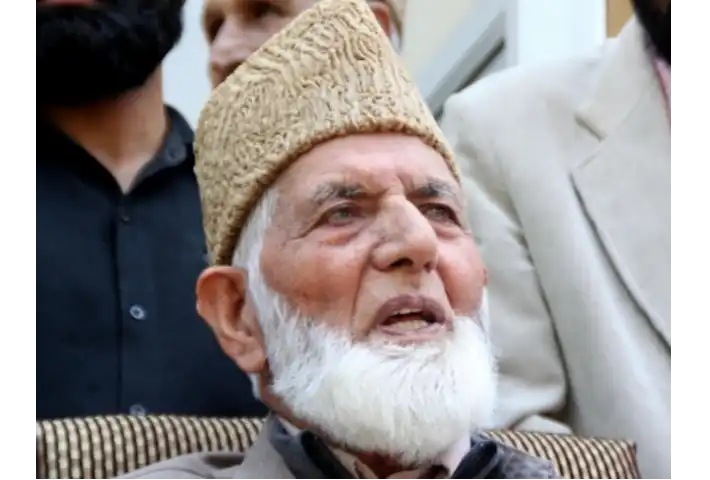Jamaat-e-Islami's highest profile leader Syed Ali Shah Geelani's phenomenal formation into an Ayatollah for Kashmir's separatist movement over the last 32 years is an irony for the organisation by many interpretations.
First, in its crusade against the traditional political and religious parties of Kashmir, the JeI was fiercely against the personality cult and the hero worship. There has been a striking similarity in the organisational structure of the religion-based ideological outfits including the JeI and the RSS where a personality is never paramount or indispensable. With a very limited base, restricted to sections of the well educated population, the JeI of Kashmir launched a multi-pronged campaign in 1960s to pulverize Sheikh Mohammad Abdullah's image of a demi-god in the valley's politics. It was fiercely critical of the Plebiscite Front's and subsequently National Conference's slogans like "Ala kari wangan kari.." (Kashmir will run as per Sheikh's sweet will). NC's personality cult diminished with Sheikh's death in 1982 but none other than Geelani, who for years acted as the JeI''s head of the political wing, ended up being a demi-god for his radicalised followers. This is an antithesis of the JeI's culture and ideology.
Second, Geelani broke away from the organisation that gave him his stature, fame, identity and electoral mandate and launched his own Tehreek-e-Hurriyat and a separate faction of the Hurriyat Conferences after his objection to the slain colleague Abdul Gani Lone's Peoples Conference participation by proxy in the Assembly elections of 2002. More ironically, Geelani drew most of his cadre from the JeI itself.
Third, Geelani never returned the material assets, including his Hyderpora house, to the JeI that is known to have acquired the same for his organisational use.
Plainly, the JeI ended up as a loser and Geelani as the gainer by all manifestations of the post-1990 situation in Kashmir. Interestingly, when there was a debate over the compulsion of the JeI's siding with the sprouting militancy, Geelani was among the leaders who spurned the idea and viewed the gun culture as 'terrorism'.
Indisputably, Geelani emerged as the most influential leader and an address of Kashmir's separatist struggle with his uncompromising attitude and Islamist rhetoric in the last around 30 years. Among all separatists, he alone demonstrated a spine to differ with the Pakistani establishment's line over resolution of the Kashmir issue when General Parvez Musharraf was the President. He was ignominiously isolated but he stuck to his guns and forced the Pakistani establishment to own and regain him soon. Contrarily, almost all other Kashmiri separatists invariably acted as Islamabad's deaf and dumb puppets. This stubbornness won him unlimited confidence of all guerrilla ranks and he alone called the shots for a pretty long time. This is why militants like Burhan Wani, by Geelani's own admission, used to call him and seek his blessings.
But notwithstanding his popularity and writ among the militants, Geelani, unlike some of his peers, was remarkably tolerant of the criticism by media and political analysts. At least three senior separatist leaders are known to have used militants and musclemen to kidnap, torture and silence their critics. Contrarily, Geelani would often ignore every virulence against him. Very rarely he would approach a court of law as happened once against the Times of India correspondent. On at least one occasion, in 2008, he made frontal attacks on the journalists working for the national newspapers and TV channels and labelled them as "tools of the Indian war machinery against the Kashmiris".
Significantly this Ayatollah of Kashmir's armed insurgency and separatist movement has passed away at a time when the entire Azadi camp is in total disarray due to the Narendra Modi government's historic organisational changes including withdrawal of the erstwhile State's special status and split into the two Union Territories. His death is arguably the second biggest setback for the Pakistan-backed secessionist movement after abrogation of Article 370. In Jammu and Kashmir, Geelani was Pakistan's biggest asset and investment as all efforts by India to win him over in the last many years had failed.
Among all leaders, none other than Sheikh Mohammad Abdullah has enjoyed massive support of people in pre-1990 J&K. In 1975, Sheikh received a hero's welcome on his entry into the Indira-Abdullah accord and his first arrival in Kashmir. Seven years later, in 1982, his death witnessed J&K's largest attended funeral march of over one million mourners. But in post-1990 Kashmir, Geelani alone matched Sheikh's level of popularity, even as it either diminished or faded into obscurity in the last few years of his physical and political life.
With Ashraf Sehrai already dead, Salahuddin in Pakistan since 1993, Mian Abdul Qayoom demobilised after August 2019 and Massarat Alam in jail since 2010, Geelani has passed away without passing the mantle of his legacy to anybody. This is why many many of his followers on social media recorded that Kashmir's separatist movement had been orphaned with Geelani's death.
By anybody's guess, Geelani's death in Omar Abdullah's or Mehbooba Mufti's political regime before 2019 would have brought hundreds of thousands of his followers on the streets. There would have been violation of the curfew restrictions and some protracted violence. However, nobody has such an apprehension after August 2019. In the changed Kashmir, Geelani's death marks the end of an era.
Also Read: Geelani buried in local graveyard near his residence in Srinagar




















